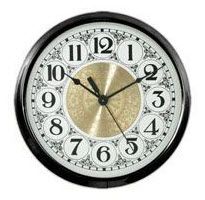Clock Parts
Understanding Clock Dials, Hands, and Movements

Clock dials, hands, and also movements are the crucial parts that enter into building a functioning timepiece. Clock dials as well as hands are the "program" component, or presentation, while movements (also known as electric motors) are the "compound" component, or the engine of control. These parts can be bought separately from an on the internet store or bought as a pre-assembled package.
Clock hands, movements, as well as dials were all at once mechanical, but nowadays the clock electric motor is electronic, as are some accessory components. We're speaking about analog clocks right here, not electronic ones, which do everything digitally. It is handy for the clockmaker who desires to build trademark heirlooms or off-the-shelf products to recognize exactly how all the numerous components interact.
We'll begin with the clock movement, as it is the part that controls the activity of the hands and gets whatever done. At its heart is a quartz crystal that, under a voltage decline, shakes incredibly rapid at an accurately accurate regularity. The resulting pulses are counted in mathematical registers, and the count is partitioned to trigger a tick every second.
Other signs up count secs to activate minute adjustments, and also minute registers trigger hour changes as the various limits are crossed. Time modifications at each degree are converted into a rotation of among three concentric shafts, and each shaft supports one of the three hands. This is just how timekeeping is displayed on the dial of the watch.
One of the most standard clock experiences a full cycle every twelve hours and just informs time. Yet movements can much more than this. They can track time expansions (24-hour, once a week, as well as month-to-month cycles) and can also report climate sensations such as humidity, temperature level, stress, as well as tide degree.
Motors can additionally carry out secondary functions, including sounding chips in synchrony with the hr and/or quarter hr. They can likewise provide oscillating accessory tabs for emulating the activity of pendulums.
If electric motors are the center of function, clock dials are mainly form. They do need to correspond to the activity they are coupled with in terms of showing the appropriate cycle (12 hrs, 24 hr, week, or month), but aside from that dials are the focus of the onlooker's eyes and also need to be pleasing yet straightforward adequate to allow quickly informing the time.
Concerns relating to the dial are essentially stylistic. There are Arabic characters, Roman numerals, or signs; the background shade may be white, ivory, black, gray, and so forth. After that one has to decide on the size of the dial as well as whether it is going on the wall or some other area.
Clock hands go hand-in-hand, as it were, with dials because they require to match or complement each other stylistically, size-wise, as well as color-wise. It is likewise a good suggestion for the quartz clock hands as well as dial history to offer a solid contrast so that it is easy at a glimpse to tell the moment.
Yet hands also present much more choices, the primary one being whether or not to have a pre-owned, and, if so, whether to choose the basic stop-and-tick activity or to have a continual move (as well as silent) used. Be sure to choose an activity that supports the sort of second hand you want. Previouslies owned are generally in a different color in comparison with the hour and also minute hands.
There are various dial, hand, and movement combinations that do things apart from telling time, such as revealing the temperature or the existing degree of the trend. There's a substantial world of capability that a timepiece can do, but constantly get the big picture of what you want prior to selecting specific components. The viewers should now have a better understanding about clock dials, hands, and movements.
April 27th, 2020